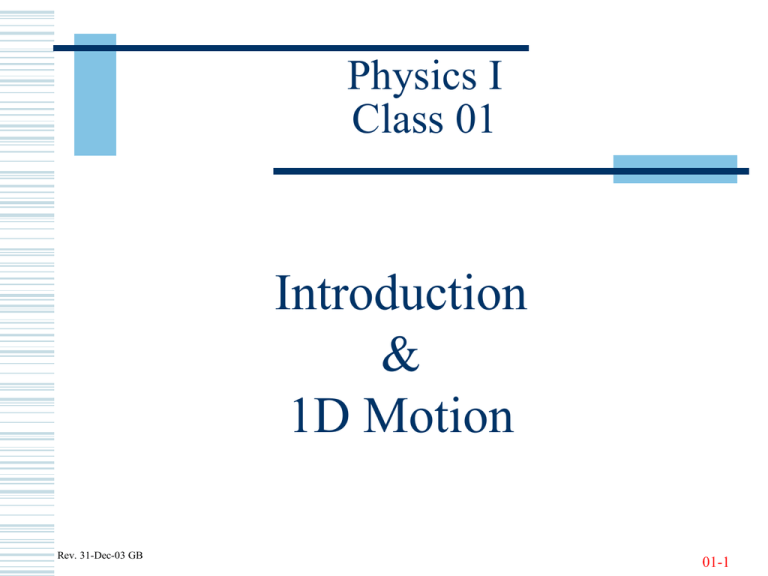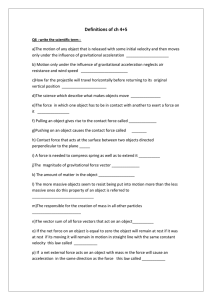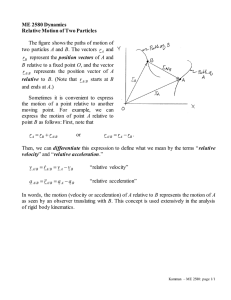Introduction & 1D Motion Physics I
advertisement

Physics I Class 01 Introduction & 1D Motion Rev. 31-Dec-03 GB 01-1 Welcome to Physics 1 at RPI Physics 1 is a calculus-based, college-level introductory course in general physics. For most of you, this is a required course. Our primary topic in Physics 1 is Newtonian mechanics. We also introduce the concepts of electric and magnetic fields. These concepts are further developed in Physics 2. Physics 2 also covers waves and introductory quantum mechanics. Physics 1 has a web site: http://www.rpi.edu/dept/phys/courses/phys1/index.htm Please add this URL to your “favorites” and check it regularly for information and announcements. 01-2 Frequently Asked Questions About the Textbook for Spring 2004 The required textbook is Fundamentals of Physics, Sixth Edition, by Halliday, Resnick, and Walker. You should buy the complete Physics 1 package including Problem Supplement #1 and the CD. You will use the same book and CD in Physics 2. If you bought a used textbook without a CD, you can buy just the CD in the bookstore. If you have a used CD, you should always download the latest activity files from the Physics 1 web site. 01-3 Format of the Course TA and/or instructor go over homework problems due today. about 20 minutes Instructor gives a short lecture covering new material for today. about 20 minutes Teams and/or the instructor work on Problems of the Day based on the new material. about 20 minutes Teams work on an activity to reinforce the new material. about 50 minutes 01-4 Our Expectations of You Come to class prepared and ready to learn. This includes – Reading the assigned material for the day. – Doing the homework problems. – Going over the class notes before class. – Paying attention to the professor and TA. Bring any problems you are having with the material to your instructor or the course director as soon as possible. Respect your classmates, instructors, and yourself by maintaining academic integrity at all times. (In other words, don’t cheat!) 01-5 Exams There will be three unit exams in Physics 1 (see schedule in the syllabus). These are always given on Tuesday evenings (6-7:25) so that everyone can take them at the same time. If you have a valid RPI excuse for not taking the exam at the regular time, there are conflict exams given the same evening. For special cases, individual arrangements should be made with the course coordinator as far in advance as possible. If you have taken all three unit exams, the final exam is optional. If you take it, we count it twice and drop the lowest single score to calculate your exam average from your best four scores. 01-6 Homework Homework assignments are generally due at the beginning of every class. Each homework problem set consists of five Regular Problems and a few Challenge Problems taken from the textbook and/or Problem Supplement #1. All homework is written and we request that you follow the format given in the syllabus and on the Physics 1 web site. You are responsible for five points of homework for each assignment. Each Regular Problem is worth one point and each Challenge Problem is worth two points. We grade the homework problems on the principles of physics that you use, not the answers, since we give you all the answers on the web site. There is homework due for all classes with a few exceptions. 01-7 Activities We will assign activity teams beginning with class #1 (this class) and reassign the teams after each exam. Part of the learning experience in Physics 1 is making your team work efficiently. We expect all team members to participate actively. Activities can include any or all of the following: Doing experiments and taking measurements. Analyzing video clips. Running simulations. Pencil and paper exercises. Each student is responsible for submitting an individual activity write-up at the end of class. These must be done on loose leaf paper, not torn from a spiral notebook. Include: Name, section number, and class number. 01-8 Activity Exercises At the end of each regular activity, there will be one or more exercises based on the material covered that day. These will be similar to exam questions. You may consult with anyone to answer these, but your final write-up must be your own. You will be graded on the methods and explanations as well as the numerical answers to the exercises. The first part of the activity is worth up to 7 points except for the exercise(s). The exercise part is worth 3 points. The maximum for any activity is 10. If you do not come to class, your activity grade for that day will be 0 unless you have a valid RPI excuse, in which case the activity does not count for or against your grade but you are still responsible for all material covered in class. 01-9 Your Grade in Physics I Your numerical grade in Physics I is based on the following formula: Exam Grades: 65% (3 unit exam average or the best 4 out of the the optional final counted twice plus 3 unit exams) Homework Grade: 10% (drop 5 points worth) Activity Grade: 25% (drop lowest activity) Your letter grade is based on your numerical grade with no rounding, using cut-offs that we determine after the final exam. Last semester it was 90.00 to 100.00 = A, 80.00 to 89.99 = B etc. It is highly unlikely that this semester will be different. 01-10 Definitions Scalar: Magnitude: Vector: A number – positive, negative, or 0. Absolute value – positive or 0. Magnitude (or length) and direction in space. Time: Position: Displacement: t(scalar) x (vector) x x x 0 Time interval: t t t 0 Average or mean velocity is defined as follows: v avg x x 0 x t t0 t 01-11 Definitions (Continued) Instantaneous velocity or just “velocity”: x d x v lim t 0 t dt Example: When you take a car trip, you get the magnitude of v avg by dividing the change in the odometer (or distance) by the hours you drove. You get many values of v during the trip by checking the speedometer moment by moment. v v v If is constant: avg 01-12 Definitions (Continued) Average acceleration is defined as follows: a avg v v 0 v t t 0 t Instantaneous acceleration or just “acceleration”: 2 v d v d x a lim t 0 t dt dt 2 01-13 Definitions (Continued) Beware: The English word “acceleration” does not have the same meaning as the physics word. In physics, any change in the velocity vector is an acceleration! Some Additional Physics I Terms: Speed: Speed Up: Slow Down: Magnitude of velocity vector. Any time the velocity vector’s magnitude increases. Any time the velocity vector’s magnitude decreases. 01-14 Components of Vectors Any vector can be written in component form: a aî bĵ ck̂ where î , ĵ, k̂ are unit vectors in the X, Y, and Z directions respectively. a, b, c are components. (Sometimes you will see x̂ , ŷ, ẑ unit vectors.) The components of a vector are scalars. They can be positive, negative, or zero. a aî In one dimension: The magnitude of a one-dimensional vector is the absolute value of its component: |a|. If a is negative, the vector points in the negative X direction. 01-15 Velocity and Acceleration We will start with 1D motion. We will deal with the X components of velocity and acceleration, v and a. a is the slope of the graph of v versus t (time). slope = a v t 01-16 Constant Acceleration For the special case of constant acceleration, the graph of v versus t is a straight line. The equation is v v 0 a t t 0 This is the same equation you had in math class for a line – [ y m x b] – but with different symbols. v slope = a v0 t0 t 01-17 Displacement with Constant Acceleration Math Fact: Because velocity is the derivative of displacement, displacement is the area (integral) under the graph of v versus t. displacement = area = rectangle + triangle rectangle: height base v 0 ( t t 0 ) triangle: 1 height base 2 1 (v v0 ) (t t 0 ) 2 1 [a ( t t 0 )] ( t t 0 ) 2 v v0 t0 t ( x x 0 ) v 0 ( t t 0 ) 12 a ( t t 0 ) 2 x x 0 v 0 ( t t 0 ) 12 a ( t t 0 ) 2 01-18 Class #1 Take-Away Concepts 1D Equations of Motion for Constant Acceleration Basic Equations 1. v v 0 a t t 0 2. x x 0 v 0 ( t t 0 ) 2 a ( t t 0 ) 1 2 Derived Equations 1 x x ( v 0 v)(t t 0 ) 3. 0 2 1 2 x x v ( t t ) a ( t t ) 4. (compare with 2.) 0 0 0 2 5. v v 0 2a x x 0 2 2 01-19 Class #1 Problems of the Day _______1. Which one graph below represents a motion for which it would be incorrect to use equations 1-5 to solve a one-dimensional motion problem – even if you broke the motion into two time intervals? Note: The respective graphs are straight line segments and v = velocity, a = acceleration. v A) v t B) a C) t a t D) t 01-20 Answer to Problem 1 for Class #1 The answer is C. Acceleration is not constant, and so it is incorrect to use equations 1-5. These apply only for constant acceleration. Graph B is a simple case of constant acceleration in one time interval. Graphs A and D are both the same type of motion, with constant – but different – acceleration values in two or more time intervals. Equations 1-5 can still be used. First solve for the motion in the first interval, then use the position and velocity at the end of the first interval as initial conditions for equations 1-5 (with a different value of acceleration) in the second interval. An example of this method is Problem 39P in Chapter 2 of your textbook. 01-21 Class #1 Problems of the Day 2. A construction worker on a new high-rise building drops a wrench and it falls 78.4 m to the ground. How fast is it moving when it hits, assuming no air resistance? Use g = 9.8 m/s2. 01-22 Answer to Problem 2 for Class #1 The first step is to determine a coordinate system. We can pick any direction as the +X direction that makes the problem easier. In this case, we pick X = 0 as the vertical position of dropping the wrench and X = 78.4 as the place where it hits the ground. Then acceleration is positive, a = +9.8 because +X is in the down direction. What variables do we know? x0 = 0, v0 = 0, t0 = 0 (start the clock when the wrench drops), x = 78.4 and a = 9.8 . We don’t know v (what the problem asks for) or t. Method A: Use eq. 2 to solve for t: 78.4 = 0.5 * 9.8 * t2 . t = 4.0 . Then use eq. 1 to solve for v: v = 4.0 * 9.8 = 39.2 m/s. Method B: We realize that we know everything in eq. 5 except v, which is what we want. v2 = 2.0 * 9.8 * 78.4 . v = sqrt(1536.64) = 39.2 m/s. 01-23 Activity #1 Software Loading / 1D Motion Objectives of the Activity: 1. Making sure Physics I software is installed and working correctly on your laptop. 2. Understanding the basic operation of the motion detector, cart, and track. (We will use these a lot.) 3. Learning general rules and guidelines that will apply to all Physics I activities. 4. Review of 1D motion. 01-24 Optional Material at the End of the Lecture Notes At the end of most lecture notes, there will be a section of extra material. This is for the interest of students who would like to get some additional depth from the course. We will not be testing on this material and you are free to skip it. 01-25 Class #1 Optional Material Deriving the Other Equations Equation 3: 3a. Solve 1 for a: v v0 a t t0 3b. Substitute 3a into 2 and simplify. Equation 4: 4a. Solve 1 for v0: v 0 v a ( t t 0 ) 4b. Substitute 4a into 2 and simplify. Equation 5: 5a. Solve 1 for (v-v0): v v0 a (t t 0 ) x x0 5b. Solve 3 for (v+v0): v v 0 2 t t0 2 v 5c. Multiply 5a by 5b and bring 0 to r.h.s. 01-26


